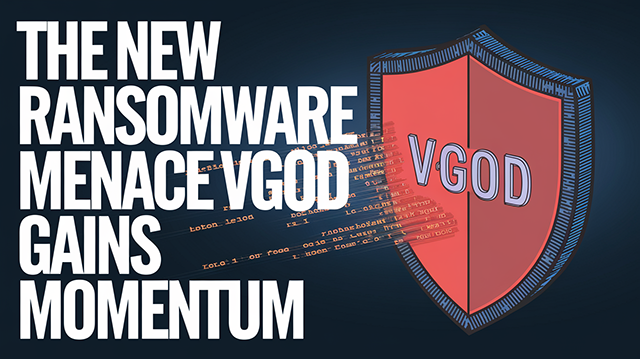The New Ransomware Menace Vgod Gains Momentum

Threat Group – Vgod Crew
Threat Type – Ransomware
Exploited Vulnerabilities – Unpatched remote code execution flaws, vulnerabilities in VPNs, weak passwords
Malware Used – Vgod Ransomware, Custom Trojanized Toolsets
Threat Score – High (8.7 out of 10) – Reflecting advanced encryption, double extortion tactics, cross-platform targeting, and alignment with broader ransomware trends
Last Threat Observation – 19 February 2025
Overview
Vgod Ransomware is a notable newcomer in the rapidly evolving world of ransomware. While specific information on Vgod remains limited, its operations reflect many broader industry patterns. Security intelligence from Q3 and Q4 2024 highlights several important themes:
- High-Value Targets: Healthcare, finance, manufacturing, and other sectors critical to economic and societal functions.
- Dynamic Attack Vectors: Increasing reliance on compromised VPNs, weak credentials, malicious macros, and supply chain infiltration.
- Rapid Encryption & Double Extortion: Encrypting files with AES-256, protecting keys with RSA-2048, and stealing data for leverage.
- Collaboration Among Threat Actors: Sharing of zero-day vulnerabilities, credentials, and infiltration tools.
This advisory consolidates technical findings, recent ransomware trends, and actionable recommendations—organized to be concise, clear, and beneficial to both non-technical stakeholders and cybersecurity practitioners. It includes tables, bullet points, and specific recommendations where possible, addressing both direct Vgod-related insights and broader ransomware defense tactics.
Key Details
To keep the technical details accessible, the following bullet points summarize critical information discovered about Vgod Ransomware and the broader ransomware landscape:
- Emergence and Affiliations
- First documented in late January 2025 on underground forums.
- Likely part of a ransomware-as-a-service (RaaS) ecosystem, benefiting from established threat actor playbooks.
- Primary Targets
- Larger Organizations with deep pockets (healthcare, finance, manufacturing).
- Broader patterns indicate professional services, education, and construction are also frequent ransomware targets in 2024–2025.
- Exfiltration and Double Extortion
- Attackers systematically steal sensitive data before encrypting systems.
- Victims risk operational downtime and public leaks of stolen files.
- VPN and Password Exploits
- Up to 30% of recent ransomware incidents linked to vulnerable VPNs or weak credentials.
- Bruteforce, credential stuffing, and exploiting outdated software remain frequent infiltration methods.
- Zero-Day Vulnerabilities
- While no direct tie to undisclosed bugs has been confirmed for Vgod, top-tier groups frequently adopt zero-days for maximum impact.
- Malicious Macros & Phishing
- Office documents with embedded macros remain a core tactic for many ransomware operators.
- Attackers rely on social engineering emails (urgent finance requests, vendor updates) to prompt macro activation.
- Supply Chain & Third-Party Risk
- Access brokers sell compromised entry points into corporate networks.
- Vgod’s apparent agility in acquiring new exploits aligns with broader collaboration trends among cybercriminals.
Attack Vectors
This table provides a concise view of typical ransomware infiltration methods, including those often associated with Vgod:
| Attack Vector | Description | Example |
|---|---|---|
| Phishing Emails | Deceptive messages containing malicious attachments or links | An email impersonating HR, urging the recipient to enable macros in a spreadsheet |
| Exploit Kits | Toolkits scanning for known vulnerabilities to deploy ransomware | Visiting a compromised website with an outdated web browser triggers automatic payload download |
| VPN Exploits & Weak Passwords | Abuse of vulnerable VPN services or brute forcing accounts | Attackers scanning for unpatched VPN appliances or guessing weak admin credentials |
| Malicious Macros | Macro-enabled Office docs initiating stealthy scripts | A “financial statement” email that silently downloads and executes the Vgod payload |
| Supply Chain Attacks | Infiltration through trusted third-party vendors or compromised updates | An IT services provider is compromised, allowing an attacker pivot access to the client network |
| Unsecured RDP Connections | Attackers locate open or poorly secured RDP ports | RDP exposed on default ports with weak logins, granting direct remote access |
| Infected Executables | Downloading files from untrusted sources | Installing cracked software from a file-sharing website that silently installs ransomware |
| Cobalt Strike Usage | Post-exploitation framework for lateral movement and control | Attackers use Cobalt Strike beacons to orchestrate a broader attack and stay stealthy |
These avenues highlight the common methods Vgod operators and other ransomware groups exploit to compromise organizations.
Known Indicators of Compromise (IoCs)
Security teams should remain vigilant for the following IoCs, integrating them into detection systems and threat intelligence platforms:
- File Hashes (MD5)
5fa2ac374a63d214dab4c3edf26e9b5dd1c18e52058910dfb188b6ada5fc45c9
- File Hashes (SHA1)
262db9327fc9ebd7a496cc70369db578cae9b2dfb0b58bb3ae0cb23d5af952efc7019caa1eadf48a
- File Hashes (SHA256)
20f6b637fcb47fb6ef8f59673fc3fdf227c83e4beaac0480588d8fbd344d14536bf927bb36710a88f9a9838f9b5131d5c978512d72c22f03f606d8fc23be3b41- Newly Observed:
241c3b02a8e7d5a2b9c99574c28200df2a0f8c8bd7ba4d262e6aa8ed1211ba1f
- Domains
vgod-update[dot]netsecure-decrypt[dot]orgcloud-recovery[dot]topvgod-c2[dot]site
- URLs
hxxps://vgod-update[dot]net/dropper.exehxxps://secure-decrypt[dot]org/VGOD/paymenthxxps://cloud-recovery[dot]top/VGOD-loader.zip
Because adversaries often rotate or abandon infrastructure to avoid detection, defenders should stay current with active threat intelligence feeds.
Mitigation and Prevention
Below are concise, actionable recommendations to protect against Vgod Ransomware and related threats. Each recommendation aims to be specific enough to guide immediate improvements.
1. Data Protection
- Regular, Immutable Backups
- Follow the 3-2-1 rule (three copies of data, two different storage media, one offsite or offline).
- Use WORM (write-once, read-many) or similarly immutable storage for backups.
- Conduct periodic restore tests to verify backup integrity and recovery speed.
- Encryption & Access Controls
- Encrypt and restrict permission on backup repositories.
- Store decryption keys separately from production systems.
2. Robust Password & MFA Policies
- Strong, Unique Passwords
- Require 14+ characters with uppercase, lowercase, numbers, and special symbols.
- Implement mandatory password changes if a breach is suspected.
- Multi-Factor Authentication (MFA)
- Enforce MFA for VPN, RDP, email, and any privilege-escalation paths.
- Periodically audit MFA logs for suspicious login attempts or bypass attempts.
3. Software Updates & Vulnerability Management
- Patch Management
- Prioritize critical updates within 48–72 hours, especially for VPN appliances and remote access tools.
- Automate patching where feasible and maintain an up-to-date asset inventory.
- Frequent Vulnerability Scans
- Conduct monthly scans on all public-facing assets.
- Remediate high-severity issues promptly, factoring in real-world exploit activity.
4. User Awareness & Training
- Phishing Simulations
- Schedule quarterly or monthly simulated phishing campaigns.
- Provide targeted training for users who repeatedly fall for phishing lures.
- Macro-Related Policies
- Disable macros by default and alert users about the dangers of enabling them on untrusted documents.
- Introduce layered email security to detect and quarantine suspicious attachments.
5. Network Segmentation & Access Control
- Least Privilege Model
- Grant admin privileges only to specific, vetted roles.
- Segment critical servers (e.g., domain controllers) from user subnets.
- Secure Remote Access
- Mandate strong authentication (MFA, unique credentials) for RDP or SSH.
- Deploy a jump server or separate VPN segment for administrative tasks.
6. Incident Response Preparation
- Incident Response Plan
- Clearly define escalation procedures, containment steps, and communication channels.
- Store essential contact information for law enforcement and third-party IR services offline.
- Tabletop Exercises
- Conduct scenario-based drills focusing on ransomware.
- Incorporate double extortion possibilities and data leak scenarios into tabletop testing.
7. Third-Party Risk Management
- Vendor Security Reviews
- Enforce minimum security standards in contracts (patch cadence, encryption at rest, MFA).
- Request third-party assessments (e.g., SOC 2, ISO 27001) to validate vendor security posture.
- Least-Privilege Vendor Access
- Restrict vendors to only the systems and data necessary for their services.
- Monitor, log, and periodically review third-party account activity.
These steps help organizations develop a multilayered defense that addresses the most common ransomware infiltration methods and tactics.
Risk Assessment
An attack by Vgod Ransomware can expose organizations to various risks:
- Operational Downtime – Fast encryption routines disrupt critical services, leading to financial and reputational losses.
- Double Extortion – Attackers exfiltrate sensitive data and threaten public leaks, pressuring victims to pay.
- Financial and Legal Consequences – Ransom demands, incident response costs, legal fees, and regulatory fines can be substantial.
- Supply Chain Vulnerabilities – Compromising one supplier or partner can cascade across multiple organizations.
- Brand & Reputational Erosion – Publicity around ransomware incidents undermines customer trust and shareholder confidence.
Conclusion
Vgod Ransomware epitomizes a modern, agile threat that capitalizes on weak credentials, exposed VPN services, and social engineering to breach corporate networks. Similar to other advanced ransomware families, Vgod focuses on rapid encryption, double extortion, and stealthy infiltration—often aided by malicious macros and third-party risk vectors. While direct details on Vgod remain sparse, broader 2024/2025 ransomware trends indicate the group likely leverages a RaaS model, quickly integrating new exploits and forging alliances with other cybercriminal collectives.
Organizations must respond with a comprehensive, layered approach: timely patch management, strong password policies with MFA, up-to-date backups, strict network segmentation, and continuous user education. Proactive tabletop exercises, along with well-defined incident response and third-party risk management protocols, will further mitigate the damaging potential of Vgod Ransomware or any similar threat. Adhering to these practices is essential to safeguarding critical data, maintaining operational continuity, and protecting organizational reputation in an ever-shifting ransomware landscape.
Podcast Section
For an in-depth conversation on how groups like Vgod exploit both technological and human vulnerabilities:
“CyberSec Threat Watch – Ransomware Revisited: Vgod’s Rapid Rise”
Audio File:hxxps://www.cybersecthreatwatch[dot]org/episodes/vgod_ransomware_discussion.mp3
Highlights
- Real-world anecdotes from incident responders detailing negotiation dilemmas and best practices for recovery.
- Analysis of malicious macro campaigns, VPN exploits, and supply chain infiltration.
- Guidance on strategic approaches to user awareness, patch acceleration, and vendor oversight.
Generic SIEM Queries
Below are sample SIEM queries to detect malicious activity related to Vgod or similar ransomware threats. Adapt them to your specific logging environment, field names, and data sources.
1. Web Proxy Logs – Possible Vgod Payloads
pgsqlCopyEditindex=web_proxy_logs
(uri="*vgod-update.net*" OR uri="*secure-decrypt.org*" OR uri="*cloud-recovery.top*" OR uri="*vgod-c2.site*") OR (file_name="dropper.exe" OR file_name="VGOD-loader.zip" OR file_name="*.exe")| stats count by src_ip, uri, http_status
Explanation: Highlights any attempt to download suspicious executables from known malicious domains.
2. Endpoint Logs – Known Malicious Hashes
pgsqlCopyEditindex=endpoint_logs file_hash IN (
"5fa2ac374a63d214dab4c3edf26e9b5d",
"d1c18e52058910dfb188b6ada5fc45c9",
"262db9327fc9ebd7a496cc70369db578cae9b2df",
"b0b58bb3ae0cb23d5af952efc7019caa1eadf48a",
"20f6b637fcb47fb6ef8f59673fc3fdf227c83e4beaac0480588d8fbd344d1453",
"6bf927bb36710a88f9a9838f9b5131d5c978512d72c22f03f606d8fc23be3b41",
"241c3b02a8e7d5a2b9c99574c28200df2a0f8c8bd7ba4d262e6aa8ed1211ba1f"
)| stats count by host, user, file_path, file_hash
Explanation: Searches endpoint logs for known malicious file hashes, including the newest addition for Vgod.
3. Windows Security Logs – Unusual Lateral Movement
csharpCopyEditindex=windows_logs EventCode=4624)
Logon_Type IN (2,3,10,11 Account_Name!="SYSTEM" Account_Name, Workstation_Name, Ip_Address
| stats count by| where count > 50
Explanation: Multiple sign-ins by the same account across various endpoints in a short time can signal credential misuse or lateral movement.
4. Task Scheduler Events – Suspicious Persistence
pgsqlCopyEditindex=windows_logs (EventCode=106 OR EventCode=114)
(Task_Name="*Vgod*" OR Task_Name="*Update*" OR Task_Name="*Recovery*" OR Task_Name="*SystemPatch*")| stats count by host, Task_Name, Creator_Process_Name
Explanation: Attackers often create scheduled tasks to maintain ransomware persistence or run encryption during off-hours.
5. PowerShell Activity – Potential Malicious Commands
pgsqlCopyEditindex=win_powershell
(powershell_command="*IEX*" OR powershell_command="*Invoke-WebRequest*" OR powershell_command="*EncodedCommand*" OR powershell_command="*vgod-c2.site*")| stats count by host, user, powershell_command
Explanation: Identifies suspicious PowerShell usage common in script-based ransomware deployments.
Sources
- Cyfirma – Vgod Ransomware
- Cybersecurity News - Vgod RANSOMWARE Encrypt Your Entire System and Set A Ransom Notes As Wallpaper
- AlienVault - Indicators of Compromise


